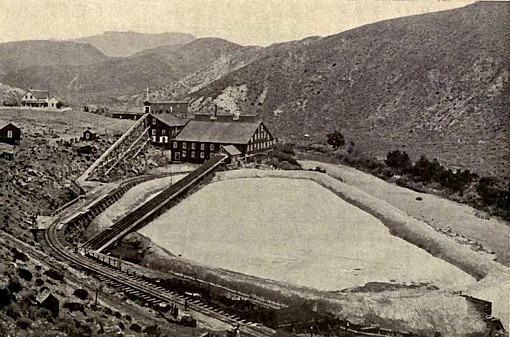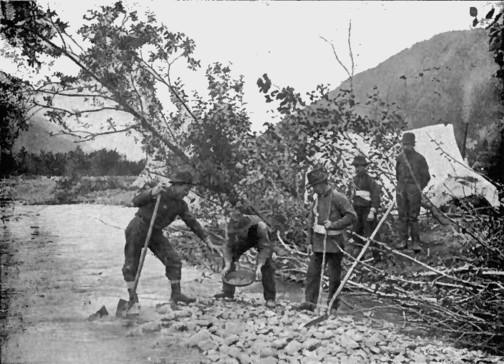There were once over 200 shipping mines in the Cripple Creek gold district, which is about twelve to fifteen miles long, with a width of from eight to ten miles. In fact, gold was being discovered in paying quantities in every direction around Cripple Creek, and it is the opinion of experts that gold-mining in this district is still in its infancy. Besides the 200 shipping mines, there are over 3,000 prospects m which new discoveries of gold are being made daily. In fact, the entire country around Cripple Creek for miles seems to be mineralized and there is no saying where gold may not be discovered. Not infrequently gold-bearing rock is discovered cropping out on the surface of the hills, varying in richness from two to hundreds of dollars per ton. Experience, however, has demonstrated that as the mines are developed deeper the per cent, of gold increases, promising beyond controversy that gold in this remarkable district will be continued to be mined by "generations yet unborn."
Cripple Creek, the chief city in the great gold district, is situated in an undulating gulch or basin, about half a mile wide and about the same length, at an altitude of 9,300 feet above the sea-level, and about thirty miles west of Colorado Springs by wagon road and sixty miles by rail, at the terminus of the Midland Terminal Railroad. The city has several churches, school house, a water system, electric light system, two good hotels the Portland and Palace which are always crowded to overflow, a number of second-class hotels and a great many rooming-houses and restaurants. While the two principal hotels charge from $3 to $4 per day, a comfortable room for a mining town can be obtained for from $4 to $6 per week, payable in advance, at a private residence, which consists of three or four rooms, kitchen included, constructed in the most expeditious style, with weather-boards on the exterior and paper used on the inside as a substitute for plaster. A room in one of these modern constructed houses, with a common stove and a large scuttle of coal, can be kept quite comfortable during sleeping hours. One of these residences generally can be erected in about two days at an expenditure of say $200, and as a rule is rented before completed for from $20 to $40 per month, according to location.
Outside of rooms and hotel accommodation, living, generally speaking, is very reasonable; a fair meal can be had for from 25 to 50 cents at the restaurants. The Illustrated World, January, 1896. The West Creek portion of the area becomes a permanent mining camp for the telluride gold ore mineral sylvanite. This rich gold ore, which made Cripple Creek famous, has at length been discovered in the seventy-foot shaft of the Hoosier claim in that Cripple Creek camp. It is asserted that a central vein has been traced across the country, from Tyler through Pemberton, West Creek and Woodland Park, almost to the town of Cripple Creek. This would give a continuous ore field where mines may be located for more than forty miles through the mountains. A coal dealer living in this city was compelled, several years ago, to take a deed for 160 acres of land in payment of a debt of $150 - he considered the land of little value at that time. This week he had an offer of $25,000 for forty acres of this land, which he accepted. After the sale he was told that the forty acres lie in the heart of the West Creek district. - From the New York Sun, Jan. 27, 1896.
Cripple Creek keeps up a hot pace of sales, leases, strikes and the formation of new companies. It cannot be too often repeated that stock speculations should not be undertaken, until something of the condition of a company is known. When possible, the standing of the individuals composing the company, their practical knowledge of mining operations, the titles of the properties owned, the debts and the locations should all be inquired into before investments are made. In too many instances the new stock companies are organized expressly for the purpose of selling stock, and not with a view to developing the claims. Already some of the new stock companies organized to operate in Cripple Creek have shown unmistakable evidences of fraud. The claims in Cripple Creek to-day all have a value because of the demand, but the intrinsic value of many of them will be found eventually to be nil. Stock companies cannot all expect to be successful even when honestly managed, and investments in stocks of prospect concerns are hazardous at best. To select then, those of the least hazards requires no little amount of investigation. – New York Sun, Jan, 1896.
It is impossible to believe that the example of South Africa will not be of wide effect. The development of the mines there has been accomplished with unlimited capital, and the best talent and best machinery which that capital could command. And despite the wild " Kaffir craze" and all the attendant stock-jobbing scandals, these mines have paid enormous profits. To-day their output of gold ore, derived from a little area perhaps three miles wide, and seventeen miles long, almost equals the entire product of the whole United States, or of all Australasia. Nor is there anything to indicate that this output has reached its limit. On the contrary, mining experts of authority predict that the product of the whole Transvaal at least will within another ten years, perhaps less, reach $100,000,000 annually. It would be absurd to attempt a similar prediction as to the yield of other portions of the earth; but certain facts remain. A very pregnant one is to be found in Colorado. For years the Centennial State talked and schemed and dreamed of little else than silver. Silver-mining was its chief industry. It cared little for gold. No one looked for it; it was almost impossible to obtain capital to develop a gold mine when it was found. This year Colorado turns from chiefly a silver state to chiefly a gold state. Review of Reviews, Feb. 1896.
The development in Colorado continues to go forward with unabated energy. The Cripple Creek field is increasing in area and population, and it is estimated that by the first of June that camp will contain 40,000 people, four-fifths of whom will be practical or theoretical miners. Editorial in Kansas City Star, Jan. 19, 1896.
Return
to The Colorado History Page:
Colorado Gold Rush History


